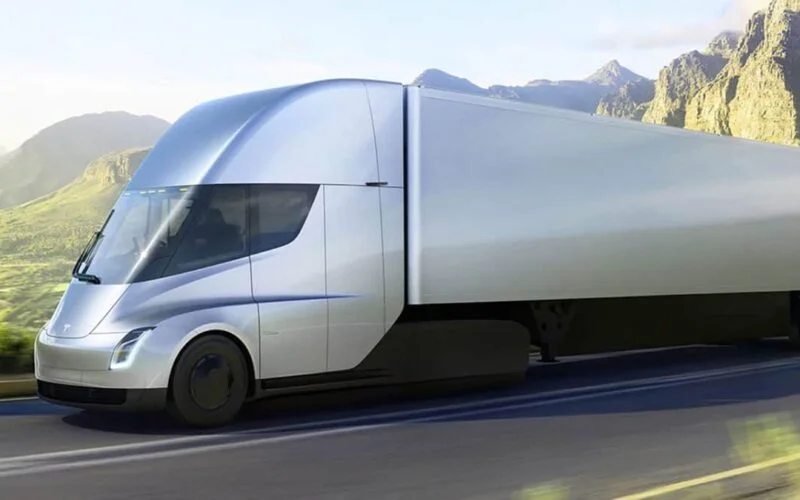The Tesla Semi-Truck is the latest development in commercial trucking technology. With its advanced electric powertrain and aerodynamic design, this vehicle promises to revolutionize how goods are transported across long distances.
This article seeks to analyze the features of the Tesla Semi-Truck and explore its potential for increasing efficiency and safety within the transportation industry. This analysis will begin with an examination of the various components that make up the semi-truck's propulsion system.
This includes a look at its battery packs, motors, regenerative braking systems, and charging infrastructure. Additionally, attention will be given to other aspects such as its weight distribution, range capabilities, driver assistance technologies, and cargo capacity.
Finally, a discussion on the economic implications of using a Tesla Semi-Truck versus traditional diesel trucks will be presented in order to provide insight into whether or not these vehicles are ultimately worth investing in.
READ ALSO: Tesla's Powerwall Battery Storage System
Overview Of The Tesla Semi-Truck
The Tesla Semi-Truck is an electric semi-truck that has been designed to revolutionize long-haul transport operations. This state-of-the-art vehicle features autonomous driving capabilities, allowing drivers to optimize their routes and maximize fuel efficiency.

The Tesla Semi-Truck also includes a robust charging infrastructure, offering rapid recharge times and increased range on longer trips. This cutting-edge semi-truck utilizes several distinct components in its advanced powertrain system.
These include four individual motors for superior performance and improved maneuverability when compared to traditional diesel engines found in competing models.
Additionally, regenerative braking technology helps further reduce operating costs while providing consistent stopping power regardless of terrain or load weight. Another key feature of the Tesla Semi-Truck is its intuitive user interface which allows for easy access to information such as route optimization, estimated time of arrival (ETA), battery level status, and more.
An array of cameras combined with real-time data from sensors provide added safety benefits by alerting drivers of potential hazards before they occur. All these elements together combine to make the Tesla Semi-Truck one of the most efficient vehicles available in today's market. With this in mind, it is clear why many see it as a major step forward for commercial transportation.
Looking ahead, electric powertrain components will be integral in continuing to drive innovation within this industry segment.
Electric Powertrain Components
The electric powertrain components of the Tesla Semi-Truck are designed to maximize performance and efficiency. The truck is powered by four independent motors, each connected to its own two-speed transmission. This allows for an optimized combination of torque, speed, and efficiency across a variety of road conditions.
Several features help ensure that the truck remains safe and reliable even under strenuous conditions:
- Battery life: With up to 500 miles range from one charge, the engine can last several days before needing recharging.
- Charging times: A fast charging system is available for quick top-ups on long journeys; it takes about 30 minutes to charge up enough juice for around 200 miles of driving.
- Safety systems: Automotive-grade safety sensors monitor the environment and alert drivers if there's any potential danger.
By optimizing these key elements of the powertrain design, the Tesla Semi-Truck ensures maximum reliability while providing a smooth ride. In terms of weight distribution, this model is built with balance in mind – every inch has been carefully considered so as not to put too much strain on any part or mechanism.
Weight Distribution
The Tesla Semi-truck has an impressive weight distribution and aerodynamic design. According to reports, the innovative hauling vehicle can reach a drag coefficient of 0.36, similar to that of a Bugatti Chiron supercar. This low drag allows for better fuel savings with less strain on its powertrain components.
Furthermore, the cab's shape was designed to reduce wind resistance during highway speeds which also contributes to improved fuel economy. Tesla engineers have managed to keep the center of gravity as close to ground level as possible in order to improve stability when cornering at high speeds or maneuvering on uneven terrain.
In addition, they've integrated air suspension into the semi-truck's frame which helps maintain traction while driving and prevents damage from bumps and potholes along the road. The use of lighter materials such as aluminum alloy helped keep overall weight down while still providing adequate strength for cargo loading capability.
These features combine together to make it easier for drivers to get through their daily routes with greater efficiency than what is currently available in other trucks on the market today.
To further enhance this experience, Tesla has incorporated advanced driver assistance systems like Autopilot and Enhanced Summon into their semi-trucks so operators can focus more time on managing freight rather than worrying about traffic conditions.
With these improvements in place, traveling long distances will be even more comfortable and efficient moving forward. As we move onto discussing range capabilities…
Range Capabilities
The Tesla Semi-Truck is capable of hauling up to 80,000 lbs and reaching a maximum range of 500 miles.
This range is made possible by the truck's battery capacity of 1.2MWh, four times greater than any other electric truck on the market.
The battery also enables the truck to reach a top speed of 65mph when loaded with a full 80,000 lbs.
Furthermore, the battery can be recharged with up to 400 miles of range in as little as 30 minutes.
Truck Range
The range capabilities of the Tesla semi-truck are highly impressive and a major reason for its popularity. This is due to the truck's ability to travel up to 500 miles on a single charge, which eliminates the need for frequent stops at charging stations making it an ideal choice for long-distance hauls.
Charging infrastructure has been improved significantly in recent years with the introduction of more widespread high-speed chargers, enabling drivers to recharge their vehicles quickly and safely.
In terms of environmental impact, electric trucks offer many advantages over traditional diesel ones; they emit no harmful pollutants or greenhouse gases while still maintaining superior performance levels.
As such, this technology offers an effective solution that can have positive impacts on our environment whilst also providing considerable economic benefits too.
Ultimately, it is clear that Tesla Semi Trucks provide an innovative transport system with numerous technological advancements that make them incredibly capable and efficient haulage options.
Battery Capacity
The range capabilities of Tesla Semi Trucks are highly impressive and a major reason for their popularity. A significant factor in this is the battery capacity, which allows them to travel up to 500 miles on a single charge.
This eliminates the need for frequent stops at charging stations, making it an ideal choice for long-distance hauls.
Additionally, due to advancements in charging infrastructure such as high-speed chargers, recharging times have been greatly reduced allowing drivers more flexibility when planning trips. Furthermore, with careful management of battery life and efficient driving techniques, further increases can be made to maximize efficiency and reduce recharge time significantly.
Ultimately, the increased battery capacity ensures that Tesla semi-trucks provide reliable transportation solutions with improved convenience over traditional diesel ones.
Driver Assistance Technologies
Tesla's semi-truck offers a range of driver assistance technologies, allowing for greater safety and efficiency. Autopilot is the primary feature that provides enhanced auto steering, adaptive cruise control, lane centering, and automatic speed adjustment. LiDAR technology supplementing this system allows for improved recognition and awareness of traffic conditions.
This combination can detect potential hazards on the road more accurately than ever before and even offer predictive warnings to help mitigate risks. Furthermore, these capabilities reduce fatigue by allowing drivers to rest while driving; however, it does not replace human attention or judgment entirely.
The integration of such advanced systems in Tesla's semi-trucks could revolutionize commercial transportation as we know it. It promises increased productivity with less time spent behind the wheel while still maintaining superior levels of safety due to its autonomous features.
All in all, these automated elements make Tesla's semi-trucks an ideal choice for any commercial fleet manager looking to leverage the latest industry innovations. By enabling safer operations with fewer resources required from drivers, Tesla has created a competitive advantage over other traditional models available today.
As such, their vehicles will be well suited to meet the demands of cargo capacity needed in delivering goods across long distances efficiently and safely.
Cargo Capacity
- Tesla's semi-truck has a loading capacity of up to 80,000 pounds, allowing it to carry larger payloads than most traditional trucks.
- The semi-truck has a total weight capacity of up to 80,000 pounds, which is significantly higher than other truck models.
- The semi-truck's fuel efficiency is an estimated up to 500 miles per charge, which is up to twice the fuel efficiency of traditional diesel trucks.
- The semi-truck's long-range battery and drivetrain technology enable it to achieve superior fuel efficiency and cargo capacity.
- The semi-truck's advanced powertrain design enables it to operate with a lower overall weight and greater cargo capacity than traditional trucks.
- Tesla's semi-truck has the potential to revolutionize the trucking industry due to its superior cargo capacity, weight capacity, and fuel efficiency.
Loading Capacity
The Tesla Semi-Truck has been lauded for its impressive cargo capacity, which is an important factor in determining the vehicle's overall usability.
Analysts have noted that this truck offers a maximum loading capacity of up to 80,000 pounds. This is well beyond what other semi trucks are able to carry and makes it one of the most efficient vehicles on the market when it comes to freight transportation.
Furthermore, due to its advanced autonomous driving technology, the Tesla Semi-Truck also boasts improved fuel efficiency and reduced maintenance costs compared with traditional diesel engines.
These features combine to make the Semi-Truck an attractive option for those who need reliable and cost-effective long-haul shipping solutions.
With such extraordinary capabilities, it is no wonder that many businesses have already begun investing heavily in this remarkable vehicle.
Weight Capacity
With a maximum weight capacity of 80,000 pounds, the Tesla Semi-Truck is able to carry more cargo than most other semi-trucks on the market. This makes it an ideal choice for businesses that need reliable and cost-effective long-haul shipping solutions.
Furthermore, its advanced autonomous driving technology also allows for improved fuel efficiency ratings compared to traditional diesel engines, ensuring that businesses can save money in the long run by using this vehicle.
Safety features such as automatic emergency braking and lane guidance help provide drivers with additional security when navigating the roads, making sure their precious cargo arrives at its destination safely.
Fuel Efficiency
The Tesla Semi-Truck offers a great advantage in terms of fuel efficiency, owing to its hybrid systems and air resistance. This means that businesses can save money on fuel costs as the truck is able to go further distances with less energy expended.
With an aerodynamic design, it also reduces drag and wind resistance, which helps increase its performance. Additionally, the regenerative braking system enables more efficient use of energy by converting kinetic energy into electricity when slowing down or stopping.
This allows for better mileage ratings for the vehicle, giving businesses greater cost savings in their transportation needs. Overall, these features make the Tesla Semi-Truck an attractive choice for those looking for reliable cargo transport solutions that are both economical and safe.
Economic Implications
The economic implications of Tesla's semi-truck are significant. The potential for cost savings through the elimination of fuel costs is a major factor in its overall financial viability.
Additionally, the pricing structure that Tesla has proposed allows customers to use their own renewable energy sources, such as solar and wind power, thereby providing long-term environmental and societal benefits.
Furthermore, due to the development of electric engines, Tesla's semi-trucks will run on much lower emission standards than traditional diesel trucks. This could lead to improved air quality across transportation hubs and reduce greenhouse gas emissions significantly.
Furthermore, this may also provide an incentive for other truck manufacturers to switch to more efficient technologies, creating a positive ripple effect in the industry.
Finally, it is clear that Tesla's semi-truck technology holds great promise for both business owners and consumers alike. From reducing fuel costs to improving air quality, these vehicles offer many advantages over traditional options without sacrificing performance or reliability.
Frequently Asked Questions
How Does The Tesla Semi-Truck Compare To Other Semi-Trucks In Terms Of Cost?
As the trucking industry searches for ways to reduce operational costs and their environmental impact, an analysis of semi-trucks is a critical step.
Comparing fuel economy and emissions standards between brands is a key factor in determining cost efficiency.
The Tesla Semi-Truck, with its advanced technology, has emerged as one of the most viable contenders for businesses looking for more financially sound options when it comes to fleet vehicles.
Compared to other similar models on the market, Tesla's all-electric vehicle boasts improved fuel economy, lower emissions standards, and a higher return on investment than any comparable diesel or electric-powered vehicle.
Does The Tesla Semi-Truck Require Any Special Infrastructure For Charging?
Recent research has indicated that the charging speed and battery life of semi-trucks can have a significant effect on their overall performance.
The Tesla Semi-Truck is no exception, as its estimated range of 500 miles per charge requires an efficient and effective charging system.
As such, this model does require special infrastructure for charging in order to optimize both cost and performance.
This includes installing specialized high-speed chargers with up to 1-megawatt capacity at locations along popular routes, allowing drivers to fully recharge their vehicles within 30 minutes while they take breaks.
How Much Maintenance Is Required To Keep The Tesla Semi-Truck Running?
The maintenance required to keep a semi-truck running is dependent on the type of vehicle and its age.
Tesla's semi-trucks require regular servicing for brakes, tires, fuel costs, charging speed, and other mechanical components as recommended by the manufacturer or owner's manual.
For example, tires should be inspected at least every 6 months and replaced when they are worn down.
Additionally, all fluid levels should be checked regularly and refilled if necessary.
Fuel costs will also vary depending on usage and distance traveled; however, Tesla provides an estimated range per charge that can help inform the user in making decisions about refueling expenses.
Lastly, it is important to note that charging speeds can affect overall maintenance requirements due to the increased use of electrical systems with higher-wattage outlets.
Can The Tesla Semi-Truck Be Used To Haul Hazardous Materials?
The transportation of hazardous materials is a responsibility that must not be taken lightly, and the importance of having an effective driver training program in place cannot be overstated.
When it comes to the use of Tesla's Semi-Truck for such purposes, careful route planning and proper maintenance are essential components for ensuring safety.
These considerations should always be made with any vehicle transporting hazardous materials; however, when it comes to electric vehicles like the Tesla Semi-Truck, extra precautions may need to be taken due to their unique characteristics.
Does The Tesla Semi-Truck Have Any Special Safety Features?
The Tesla Semi-Truck contains several advanced safety features that are not found in traditional semi-trucks.
It is equipped with a driverless capabilities system, which allows it to respond quickly to changing road conditions and avoid potential hazards more effectively than manual driving.
Additionally, the truck has an autopilot system that can detect obstacles and automatically adjust steering, speed, and braking accordingly.
The combination of these two systems results in a safer ride for both drivers and passengers alike.
Conclusion
The Tesla Semi-Truck has the potential to revolutionize the transportation industry. Its low cost, minimal maintenance requirements, and advanced safety features make it an attractive option for those looking to invest in a semi-truck.
However, its use of specialized infrastructure and inability to haul hazardous materials may limit its appeal among certain operators.
Despite this, there is no doubt that the Tesla Semi-Truck will have a lasting impact on how goods are transported around the world. As technology advances and charging stations become more widespread, it can only be expected that the Tesla Semi-Truck's popularity will continue to grow.
Thank you for reading our article today! Please remember to share this article on social media to help others benefit too. It also helps us improve our algorithm and relevance to the public. Thanks for Sharring!!! Follow us on Socials: Facebook - LinkedIn - Twitter









